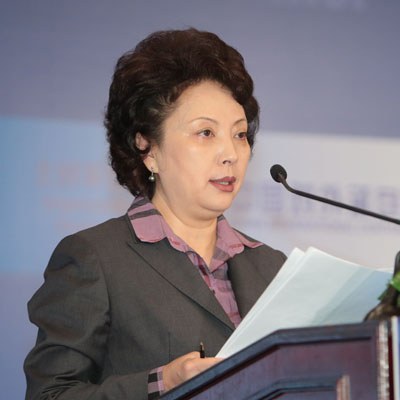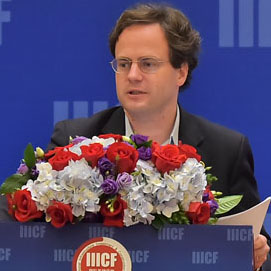Your are Here : Home> IIICF > Information Center > VIP Speakers
Making PPPs work for Highways

Over recent years, the Chinese Government has put forward the B&R Initiative and subsequently launched a wide range of innovative platforms including the AIIB, the Silk Road Fund, and the China-Eurasian Economic Cooperation Foundation for financing cooperation. These rollouts have been well received and drawn extensive participation. However, economic development varies dramatically among countries covered by the B&R Initiative, which are
suffering from such problems as high government debt and a dearth of construction funds. In particular, these countries lack access to financing for infrastructure projects in such sectors as railway, road, airport, and harbor typified by a long construction cycle. This necessitates construction enterprises to transform their business model, readjust the investment strategy, deepen cooperation with financial institutions, and work towards a new direction and model of investment & financing for cooperative infrastructure projects.
Growing urbanization and a burgeoning middle class are the new hallmarks of many developing nations, in turn leading to growing disposable income and new mobility aspirations, as illustrated by the sale of powered two wheelers in India (30,000/day) or personal vehicles in China (>EU 28). Income elasticity of vehicle ownership is the highest when countries reach middle-income levels ($3,000 - $10,000 per capita). Altogether, 70 developing countries home to 4 billion people lie in this per capita range. Given the underlying fundamentals, there is no reason to believe this trend will reverse or slow down over the next decade.
There is a well-documented infrastructure deficit in many developing countries, which is hampering growth prospects. The financing gap for infrastructure coexists with excess savings in the global economy including a growing pool of savings in the EMDEs themselves. The challenge is to transform the excess savings into stable, predictable and scaled finance while providing investors a safe high quality asset.
Both pictures taken in South Africa: toll gantry on Gauteng’s national road 17 in South Africa. An equally representative illustration is provided, right, with an unpaved trail in South Africa’s diamond country. Both are important for a country’s economic vitality – and both qualify for private sector participation. In fact, over 90% of motorists who pass under the gantry to the left avoid paying the toll, which suggests this project financing mechanism may not have been appropriate for this particular road. By contrast, China’s Yunnan Province has successfully outsourced the routine maintenance of unpaved rural roads by maintenance service providers who are remunerated based on service level indicators.
Private sector road contracts vary primarily by asset type, private sector responsibility and method of payment to the private sector.
Single out growing use of OPRC: OPRC can be used to…?Manage and maintain existing good roads over multi-year periods. Bring roads to a maintainable condition and then manage and maintain them for several years. Rehabilitate and improve roads, and then manage and maintain them for several years. Construction of new roads, followed by a long period of management and maintenance.
There are risks that the private sector is not willing to accept because they are perceived as excessive or beyond their control. In those circumstances, certain defined risks can be transferred from project financiers (lenders and equity investors) to creditworthy third parties (guarantors and insurers) that have a better capacity to accept such risks.
The vulnerability of PPP projects to changing political, financial and economic circumstances is often underestimated
PPPs enable the public sector to realize infrastructure projects by making use of the skills and experience of the private sector.
The creation of a PPP Unit, reporting directly to or at least strongly backed by the Head of State, will provide the necessary concentration
of expertise and inter-ministerial coordination to develop and implement a PPP procurement process. A suitably funded PPP Unit can harness resources, from within government and external sources, to create the legal and institutional framework that will enable fair and efficient procurement.
Successfully concluding a transport PPP is a challenge:
As a result of unrealistic and aggressive bids, a large number of projects face re-negotiation
Government commitment can disappear in periods of financial stress
Historically only 55% of proposed projects have reached financial close.
Factors that affect the viability and attractiveness of PPP include its project size, the level of its operating costs, the nature of cost recovery mechanisms (particularly where tolling is allowed / feasible), the level of private sector interest which will determine the results of the bidding process, the level of risk acceptable to the private sector, the existing of PPP transactions within the same sector or legislative framework, and the desired completion date (with traditional procurement methods often offering a quicker route).
The Dakar-Diamniadio toll highway (DDTH) project was developed in 3 phases to provide a high-quality, tolled dual-carriageway highway from central Dakar (population 2.5 million) through the eastern suburbs and onwards to the national highway network to the east. The highway will also serve Dakar’s new airport, scheduled to open in July 2015.
The highway’s main objective is to encourage the economic development of Senegal’s main economic center, by reducing transport congestion and associated costs and encouraging a sustainable spatial distribution of economic activities and housing within and outside the peninsula.
The early creation of the Agence nationale chargée de la promotion des investissements et des grands travaux (APIX) as a ‘PPP Unit’ in Senegal was a critical factor in the successful procurement of the Dakar- Diamniadio Toll Highway. As its name implies, the agency is tasked with promoting foreign direct investment and overseeing the implementation of large-scale infrastructure projects
The early involvement of international partners, such as the World Bank, the African Development Bank and the French Development Agency also ensured that the social and environment aspects of the project were properly assessed and addressed at planning and design phase.
No fewer than 3 laws and 2 decrees were either introduced or updated to articulate the legislative and institutional framework for implementing a program of PPP procurement, at national and local level. Crucially, Senegal’s PPP law was refined in 2009 in the light of shortcomings encountered in implementing the DDTH concession.
The highway was developed in three phases. Phase 1, from central Dakar to Pikine and completed in 2009 by traditional procurement methods, comprises a single toll plaza on its eastern section. Phases 2 and 3 (about 20 km in total) opened on August 1, 2013 and were procured as a PPP project to the French concessionaire Eiffage, who took on all the engineering and traffic demand risks.
Financial risks, such as exchange rate fluctuations, are largely borne by IFIs and Eiffage. The latter stated for the purpose of this work that 60% of their payments would be in Euro (e.g. bitumen and surveys).
Of note, no international commercial bank finance was provided to the project.
This was a high profile infrastructure project for Senegal receiving leadership endorsement within the highest spheres of the Government of Senegal. Here we see sitting President Macky Sall at the formal inauguration of the completed highway in August 2013.
At the time of the formal opening, the concessionaire undertook a public relations campaign to encourage the use of the new toll road
As of November 2013, daily traffic volumes on the toll portion of the highway 23 average 28,000, in line with forecasts.
A remarkable aspect of Indonesia’s program is how old it is. A 60 km stretch of toll roads opened in 1975. Although the first privately owned concession only opened in 1987. Another remarkable characteristic is the scale of some of the projects in the government’s pipeline. The Trans Sumatra Highway is a 2,700 km long toll road consisting of 23 segments crossing Sumatra Island from North to South with a total project cost of ~US$ 30 Billion.
Jasa Marga, part operator, part regulator was established in 1978.
[pictured: Bali Mandara Expressway which connects the international airport with Denpasar and was inaugurated in 2013]
Demand risk linked to unique features of Indonesia’s geography, such as its uneven population distribution and limited economic industrial activity outside Java (which concentrates 60% of the population) and most of the country’s infrastructure). There is strong political support for development of areas outside Java despite lower capacity by users to pay for tools.
In many ways, Indonesia’s highway program is characterized by High Economic Benefits but Low Financial Viability. Consequently, projects are not always prioritized in a way to optimize successful delivery.
Many project’s Financial Rates of Return do not attract interest of the private sector (required FIRR of 18-20%). To increase FIRR, the government has had to step in by providing partial construction support, a form of Viability Gap Funding with which government will provide the capital contribution by constructing some of the assets instead of providing money for the private sector. Of course, this in turn induces a new risk linked to the quality of the asset delivered by the government.
A separate concern relates to land acquisition issues which have delayed flagship projects. Among the issues faced are informal ownership causing land disputes and speculators refusing to sell the land hoping for higher prices in future.
This has negatively impacted the TRANS JAVA TOLL ROAD (a USD 5.5 BILLION highway program to connecting West to East Java. As a consequence of slow land acquisition, the secured funding might not be sufficient to complete the project, due to increased project costs (increased prices of materials, equipment and land) - causing additional delay on top of the delay caused by the lengthy land acquisition process.
This issue is being progressively remedied with the introduction in 2012 of a Presidential regulation on the acquisition of land for public use (note: this law does not apply to the Trans Java Toll Road).
The situation is encouraging government and industry to collaborate on hybrid models that combine the features of BOT and PBAs (Performance Based Agreements)
Examples of innovations: include the development of industrial and commercial area along the road, in-situ events, bazaars, market.
-

Investment facilit...
As the speaker, Wang He, Vice Chairman of China International Contractors Association stated that through the implementation of the investment facilitation arrangements under the framework of FTA, C...
-

Making PPPs work f...
The financing gap for infrastructure coexists with excess savings in the global economy including a growing pool of savings in the EMDEs themselves.
-

New opportunities...
Mr. Robert Goodwill,( Minister of State, Department for Transport, United Kingdom) said in his speech that Chinese contractors are fresh in investing in the UK. The cooperation between Department fo...
- The 7th IIICF Invitation-english version 788
- The 7th IIICF Preliminary Proposal 430
- CCTV- Annual Report on Chinat International Project Contracting Released 333
- CCTV- China Oversea's Contracting Projects Hit Another Record High 269
- Phoenix- The 6th IIICF was held in Macao 261
- CCTV- The 5th IIICF was held in Macao 249
- The Fifth International Infrastructure Investment & Construction Forum was held in Macao on May 8-9, 2014 245
- China Daily's Big Talk- The 5th IIICF was held in Macao 217
- 13th IIICF Forum to be held in Macao 0



